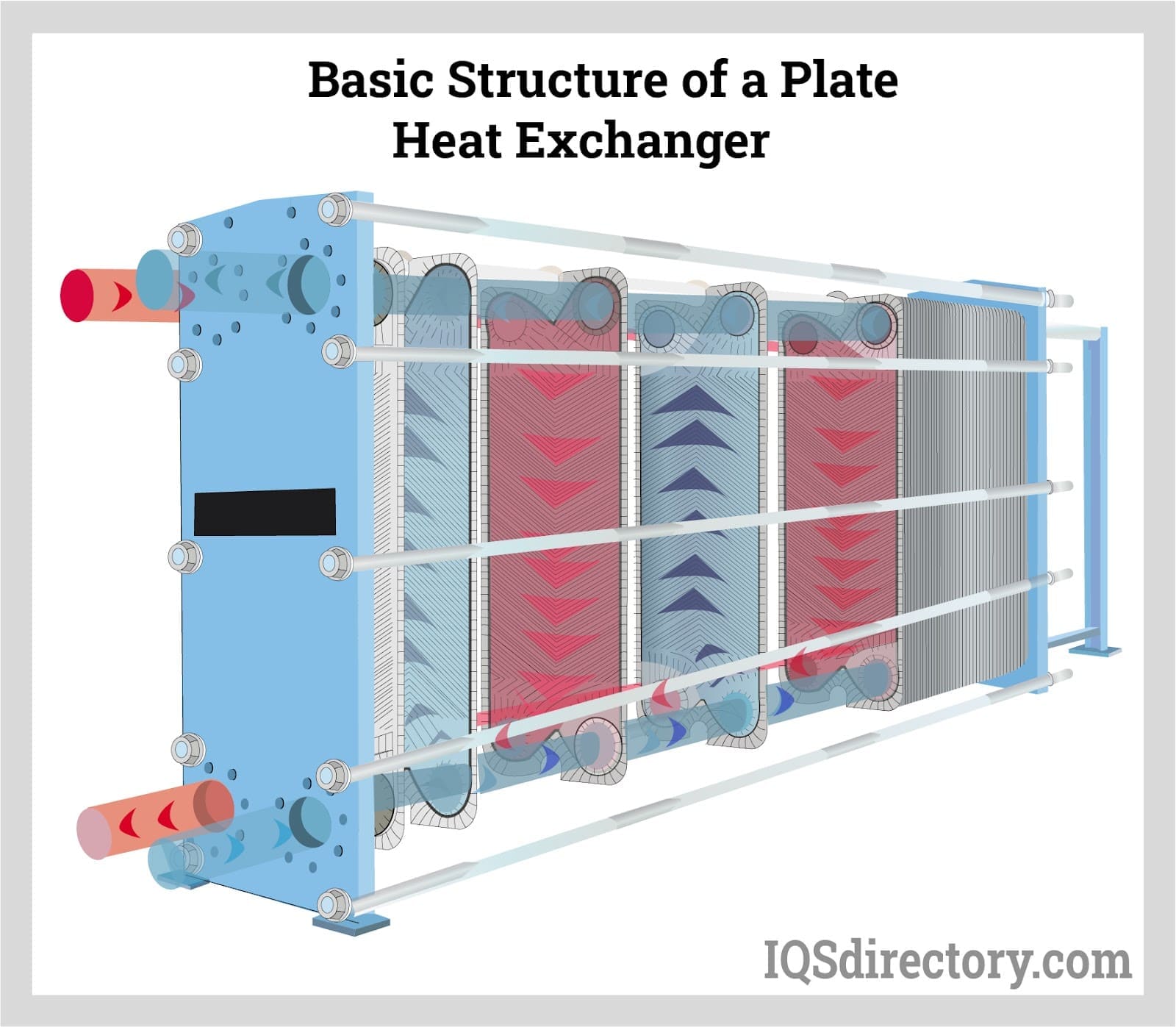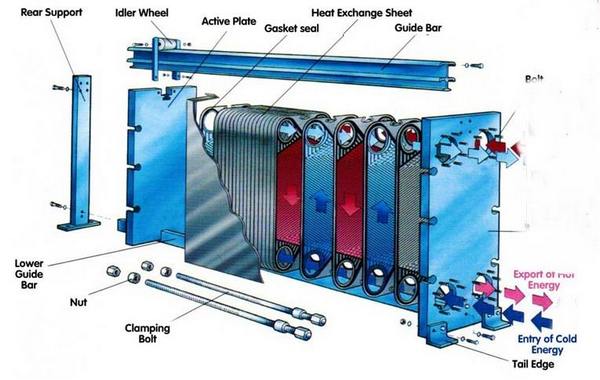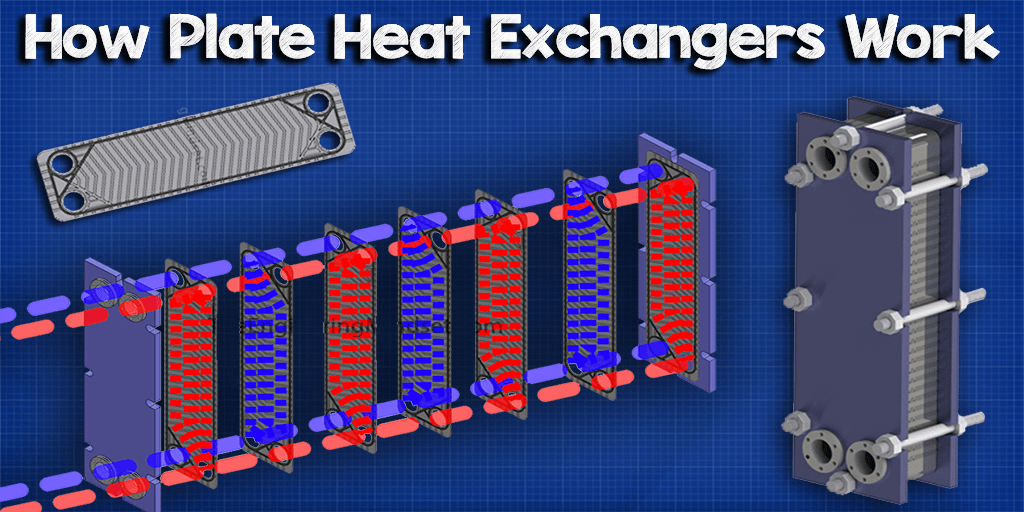AHRI 400-2001 with Addenda 1 and 2. I found the Code Case 2766 it does not require any design calculations or proof testing for establishing the MAWP for gasketed plate packs provided all 6 conditions of CC2766 are met.

Brazed Plate Heat Exchanger 40 Plates 5 X12 1 1 4 Mpt 530 000 Btu Heating Systems Heat Exchanger Domestic Hot Water
Heat exchanger HEX design is a complex multiobjective problem strongly defined by the application but also by the limitations of fabrication technologies.

. H overall heat exchange coefficient kWm 2 K-1. Flow ports and associated pipework are sized in proportion to the plate area. If its not possible only the.
Full vacuum to 150 bar. The entire unit shall be hydrostatically tested according to the ASME Code Sect. Plate type heat exchanger uses metal plates to transfer heat between two fluids.
1 for 13x Design Pressure at maximum working temperature. The methodology employed for the design of a PHE is the same as for the design of a tubular heat exchanger. Due to this unique construction Vahterus Plate Shell Heat Exchangers can meet very demanding design conditions.
The general principles of the mechanical design of the following types of exchangers are given in the Heat Exchanger Design Handbook 1994 and full descriptions of each are given under the corresponding entries in this encyclopedia. DIN EN ISO 12211 - Petroleum petrochemical. All Vahterus heat exchangers are designed with the required design codes such as.
ASME units require ASME relief devices per UG-125 of ASME Code Section VIII Div. Up to now I only can find API 662 - Plate heat exchangers for general refinery services. Liquid to Liquid Heat Exchangers was developed for plate and frame heat exchangers because many applications in commercial HVAC systems were designed with very.
Code-qualified compact heat exchanger in IHX or SHX nuclear service. Various materials options including stainless steel grades 304 316 SMO254. Plate Heat Exchanger Design.
In the PHE the plates create a frame where the plates are pressed with headers and tie bars and the seal is guaranteed by gasketsGaskets in addition to their sealing effect serve to direct the flow of the fluids and are placed along the grooves at the edges of the plates. Wide size range from small to large up to 1 500m3h. A plate heat exchanger is a type of heat exchanger using metal plates to transfer heat between two fluids never encountering each other due to being separated by the heat exchanger.
TYPICAL PLATE HEAT EXCHANGER ASSEMBLY PROCEDURE. Plates are pressed in materials between 05 and 12 mm thick and plates are available with effective heat transfer area from 003 to 35 m 2. K 47 i t t t d h Nu where is the Nusselt number for the tube-side fluid which is found by using Eqs.
Power-line plates for high thermal performance and Standard-Line plates which are relatively dirt resistant. Employing a xed heat exchanger geometry allows the performance of a given heat exchanger to be evaluated as. 1 or 2 applies.
Each plate in the plate pack is individually inserted into the frame in the correct order as per the final duty design. The objective of this paper is to optimize the design of plate heat exchanger by reducing its number of plates. Fizza453 Mechanical OP 20 Mar 17 1214.
The potential for AM to generate complex shapes especially in high temperature tolerant alloys that are typically difficult to work 147 has generated a lot of interest in the community. Starting point of this design is to define given properties. For a given heat exchanger de ned by heat exchanger type a range of variables de ning the geometry of the heat exchangers selected heat transfer correlations and selected pressure drop correlation the exchanger performance is evaluated.
Most effort will focus on the IHX since the safety-related Class A design rules are more extensive than those for important-to-safety. This design project aims to propose a plate type heat exchanger that can meet given heat duty and find the number of plates required. The maximum temperatures used for sealing heat exchangers are.
Dear all Im looking for design standard for Plate and Frame heat exchanger. Of Process Equipment Design PLATE HEAT EXCHANGER SELECTION SIZING AND TROUBLESHOOTING ENGINEERING DESIGN GUIDELINES Page 7 of 97 Rev. Plate and Frame Heat Exchangers.
Unlike other types of heat exchanger on which design procedure data is available the designing of plate heat exchanger is a monopoly of certain manufacturing companies. This article is about the design working principle and an introduction to different types of Plate Heat Exchanger. The Plate unit shall be designed to withstand full design pressure in each circuit independently.
4214 Tube-Side Heat Transfer Coefficient The heat transfer coefficient for the tube-side is expressed as follows. The equations given in the present chapter are appropriate for the chevron type plates that are used in most industrial applications. The Plate Frame Exchanger shall have the capacity for future expansion of at least 20.
3Once the plate pack is inserted the tie bars are put in place. Design Standards For Plate And Frame Heat Exchanger - posted in Industrial Professionals. 02 Rev 02 Feb 2020 These design guideline are believed to be as accurate as possible but are very general and not for specific design cases.
The codes cover all aspects of the construction of heat exchangers except the types of service loads other than pressure and the thermal design. Under ASME rules if the operating pressure is higher than 15 psig then the heat exchanger is considered a pressure vessel and the pressure-vessel design code ASME section VIII Div. From -270C to 750C.
Shell and Tube Exchangers. Guide for the mechanical design materials selection fabrication inspection testing and preparation for shipment of plate-and-frame heat exchangers for use in petroleum industries applicable to gasketed semi-welded and welded plate-and frame heat exchangers. Plate Fin Type Exchangers.
Basic equations for the design of a plate heat exchanger. However plate heat exchangers which can operate at pressures up to 25 bar are available. November 1 2018 - API.
44 and 46 k is the thermal conductivity of the tube-side fluid and is the tube inside diameter. T hi inlet temperature of hot fluid K It is then possible to approximate the size of the heat exchanger by estimating the overall heat transfer coefficient H. Similar logic applies to different pressure vessel.
Up to 700 plates can be contained within the frame of the largest Paraflow exchanger providing over 2400 m 2 of surface area. The plate heat exchanger frame and connections are assembled and the plates start to be put in place. The normal maximum operating pressure for a plate heat exchanger is generally 16 bar for ASME-code units.
I would be very appreciated if you can provide me content of those standards. H for plate heat exchanger is often in between 2 to 7 kWm 2 K -1. We supply and manufacture Thermowave plate heat exchangers.
MAWP of other pressure retaining parts will govern the design. Plate Heat Exchangers for General Refinery Services Part II. This standard gives requirements and recommendations for the mechanical design materials selection fabrication inspection testing and preparation for shipment of brazed aluminum plate -fin heat exchangers for use in the petroleum petrochemical and natural gas industries.
This makes the problem worse. The heat exchanger during maintenance. 1 Preventing Excessive Pressure.

Plate Heat Exchangers Components Types Applications And Advantages

Heat Exchanger Manufacturer Heat Exchanger Solar Heating Radiant Floor Heating

Plate Heat Exchangers Layout The Piping Engineering World

How Plate Heat Exchangers Work The Engineering Mindset

Basic Structure Of Plate Heat Exchanger Phe Source Reproduced With Download Scientific Diagram
Ab Brazed Plate Heat Exchanger 20 Plates 5 X12 1 1 4 Mpt

Ab Brazed Plate Heat Exchanger 20 Plates 5 X12 1 1 4 Mpt

25 Plate Heat Exchanger Configuration Download Scientific Diagram
0 comments
Post a Comment